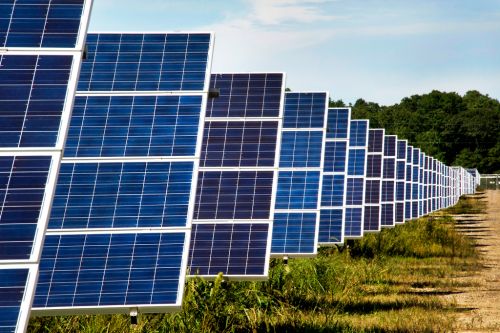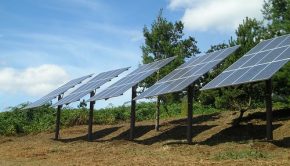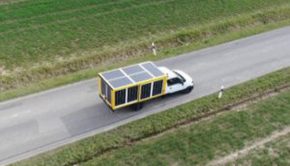Residential Solar Is Hurting Under Coronavirus. Community Solar May Be More Resilient
Residential Solar Is Hurting Under Coronavirus. Community Solar May Be More Resilient

Netflix and a few other “stay-at-home” stocks are riding high as markets have slumped in response to the coronavirus pandemic. In the U.S. solar industry, interest in subscription services may provide a much-needed anchor as well.
While often overshadowed by the larger residential solar market and its stock-listed installers like Sunrun and Tesla, community solar has grown quickly in states where it’s available and may prove hardier than other segments of the industry during the COVID-19 lockdown.
Though often framed as an alternative to residential solar, community solar — also called shared solar — diverges from the home solar market in siting, development and economics. Rather than allowing installers up on the roof to lay panels, community solar customers subscribe to a large off-site solar project and then receive credits that bring down their utility bill.
The community solar market has gained momentum — 40 states now have at least one project online — but it remains relatively small. There are 2.1 gigawatts of community solar capacity in place in the U.S. today, compared to the 2.8 gigawatts of residential solar installed last year alone.
But as residential companies work through their existing pipelines and prepare for a future where demand may fall off a cliff, many community solar developers say their subscription numbers have held steady.
Arcadia, a subscription organization based in Washington, D.C., said its growth rate has plodded along through February, March and April, with no spikes in member cancellations. Boston-based community solar developer Nexamp told Greentech Media it’s currently working to add around 60 people to its staff.
Developers acknowledge that times are uncertain, and no portion of the industry will avoid financial pain. Even community solar companies will need to change the way they do business, said Sandhya Murali, co-founder and COO of Boston-based Solstice, which works on customer acquisition and customer management for community solar projects.
But as it stands, community solar companies look relatively well positioned to weather the pandemic. “Our perspective is that we can be insulated to a certain extent,” said Murali.
An edge for community solar amid uncertainty
Though categorized as an “essential” business under most coronavirus shutdown orders, all parts of the solar industry have reported some challenges related to the coronavirus, the resulting economic downturn and the general environment of uncertainty.
The great majority of the industry’s job cuts since March 1 have been concentrated among residential solar employees, according to survey data compiled by trade group the Solar Energy Industries Association. Sungevity cut nearly 400 jobs, for instance, and national residential leader Sunrun laid off at least 100 employees. SunPower reduced executive salaries and froze hiring.
A few factors make home solar uniquely exposed to a coronavirus-related decline. Rooftop projects generally require decades of commitment, onsite installation at a home and, depending on the type of financing, upfront investment.
Community solar gardens, in contrast, are installed off-site, contracts can be as short as one year, and though companies still rely on in-person events to sign up subscribers, the transaction is often carried out entirely online, requiring no face-to-face interaction.
“For the customer, when you’re choosing rooftop solar, you have to make a choice [between] buying and outlaying a lot of cash [and] leasing or doing a loan and signing up for a long-term debt obligation?” said Kiran Bhatraju, founder and CEO at Arcadia. “The way we’ve structured community solar, you don’t have to pay anything upfront.”
That may offer community solar an edge in an uncertain economic landscape. Residential solar providers often pitch customers by showing how self-producing electricity on their roof can beat out the electricity prices forecast for the next couple of decades. But those electricity prices are subject to change depending on factors like a utility’s rates and investments.
Community solar providers often offer a guaranteed discount of up to 15 percent on the utility’s price. On top of savings, Solstice pays certain customers for referrals.
Historically, residential solar and community solar providers haven’t necessarily gone after the same customers. Residential solar is more widely available, may increase property value for homeowners and, depending on the market, may prove to be a better deal. Community solar served as an alternative for renters, homeowners with shaded roofs or those looking for less of a financial commitment.
“To date, I do not think they have been in direct competition,” said Austin Perea, a senior solar analyst at Wood Mackenzie Power & Renewables. “People who go the [community solar] route are typically people who are in some fashion constrained from doing rooftop solar.”
But because of its lower commitment and higher flexibility, Perea said community solar looks to be more insulated from the impacts of a recession. It’s possible the new environment will push more customers to consider community solar over residential installations.
Still, 2020 will be “a challenging year” for every company
Despite those apparent advantages, community solar providers are working through several of the same challenges as their peers, as the coronavirus pandemic disrupts traditional ways of doing business worldwide.
“For community solar, it’s going to be a challenging year. I don’t think there’s any doubt about that,” Nexamp CEO Zaid Ashai told Greentech Media.
Boston’s Solstice is considering some belt-tightening, the company said, but declined to provide more details.
State and city shutdown orders have halted the door-to-door sales techniques used by both residential and shared solar, and canceled community events that help companies reach subscribers. That’s made it more difficult to reach consumers, especially those who may not already be familiar with community solar.
“Community solar is a complicated product, even if the economics are fairly straightforward,” said Joel Thomas, executive vice president of development at Pennsylvania’s Community Energy. “Having some face-to-face contact tactically, from a sales standpoint, is pretty helpful.”
“You can do mailers, you can do over the phone, but that’s going to slow things down,” Thomas added.
For many companies, that’s forced innovation. After a slowdown in March, Solstice said it’s beginning to realize the returns of its digital efforts and phone outreach, though it’s unclear if they’ll match their previous momentum.
Construction and permitting delays are also hitting projects across the industry, albeit unevenly. Though community solar, like large-scale projects, can take advantage of slightly longer building timelines, construction has been put on hold in important community solar markets like New Jersey and New York.
But the sector is also finding some comfort in its adaptability. “Flexibility is key” as the market wrestles with uncertainty, said Jeff Cramer, executive director at trade group the Coalition for Community Solar Access.
“We could not have predicted a month ago today that we’d be in this situation, so [looking] out a couple of months is still a question mark,” said Cramer. “Based on what we know today, it does seem like there is a clearer path forward for us [than for the residential market].”
***
A new Wood Mackenzie research insight discusses the impact of coronavirus on the non-residential solar market in the United States. WoodMac also published a recent insight on residential solar and coronavirus.








